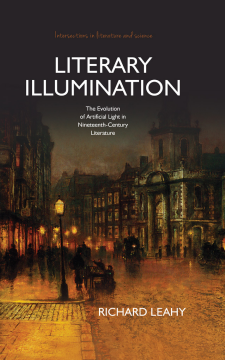
Additional Information
Book Details
Abstract
Literary Illumination examines the relationship between literature and artificial illumination, demonstrating that developments of lighting technology during the nineteenth century definitively altered the treatment of light as symbol, metaphor and textual motif. Correspondingly, the book also engages with the changing nature of darkness, and how the influence of artificial light altered both public perceptions of, and behaviour within, darkness, as well as examining literary chiaroscuros. Within each of four main chapters dedicated to the analysis of a single dominant light source in the long nineteenth-century – firelight, candlelight, gaslight, and electric light – the author considers the phenomenological properties of the light sources, and where their presence would be felt most strongly in the nineteenth century, before collating a corpus of texts for each light source and environment.
Table of Contents
| Section Title | Page | Action | Price |
|---|---|---|---|
| Cover\r | Front Cover | ||
| Title Page\r | iii | ||
| Copyright Page\r | iv | ||
| Contents | v | ||
| List of Illustrations | vii | ||
| Introduction: The Nineteenth-Century Lightscape | 1 | ||
| Chapter 1: Firelight | 9 | ||
| 1.1: Nineteenth-Century Firelight: Hearth, Home and Industry | 10 | ||
| 1.2: Gaskell, Dickens, Fire and Reverie: The Domestic and the Individual | 18 | ||
| 1.3: Variable Flames in Urban Domesticity | 28 | ||
| 1.4: Fire and Reverie in Industrial Desperation | 38 | ||
| Chapter 2: Candlelight | 49 | ||
| 2.1: A Brief History of Candlelight: An Ancient Light in the Nineteenth Century | 50 | ||
| 2.2: Candle Theory and its Symbolic Value in Literature | 53 | ||
| 2.3: The Candle and the Literary Detective | 60 | ||
| 2.4: The Candle and the Gothic Unknown | 71 | ||
| 2.5: The Candle and Ambiguity of Mental States | 82 | ||
| Chapter 3: Gaslight | 91 | ||
| 3.1: Gaslight in the Nineteenth Century | 92 | ||
| 3.2: The Networked City: Gaslight on Literary Streets | 103 | ||
| 3.3: The Theatre: Gaslight’s Stage | 114 | ||
| 3.4: The Department Store: Gaslight’s Dressing Room | 126 | ||
| Chapter 4: Electric Light | 137 | ||
| 4.1: Electric Light in the Nineteenth Century: Evolution and Revolution | 138 | ||
| 4.2: Jules Verne’s prophetic electric light of the 1860s and 1870s | 149 | ||
| 4.3: The Transient Light of H. G. Wells’s Fin-de-Siècle | 162 | ||
| 4.4: Electric Light 1900–14: Realisation and Realism | 174 | ||
| Summary and Conclusions | 189 | ||
| The Lightscape of the Early Twentieth Century: Why Stop Here? | 189 | ||
| The Key Ideas: Blurring of Archetypes, Modernity and the Individual | 193 | ||
| Notes | 197 | ||
| Bibliography | 221 | ||
| Index\r | 239 | ||
| Back Cover | Back Cover |
